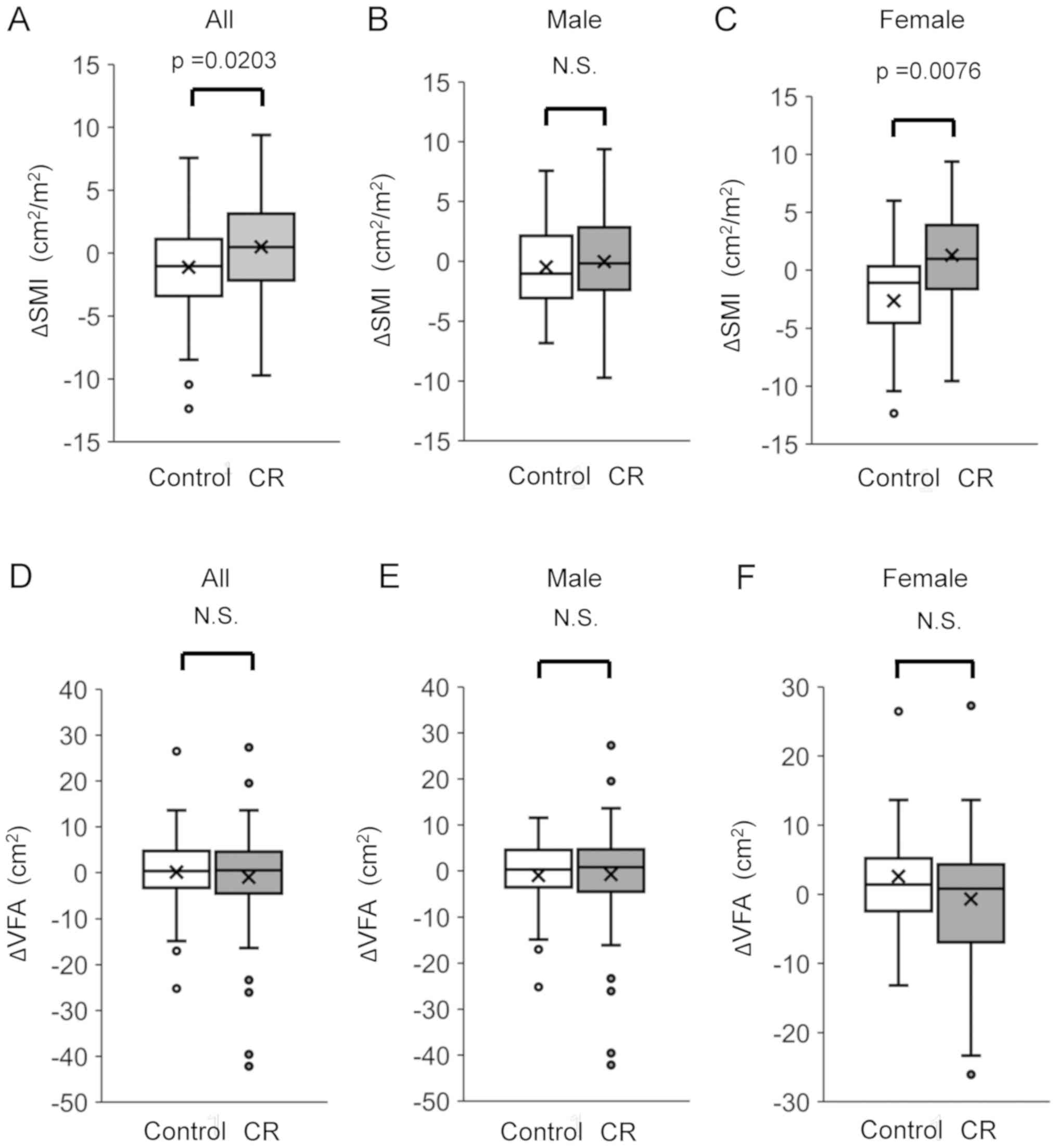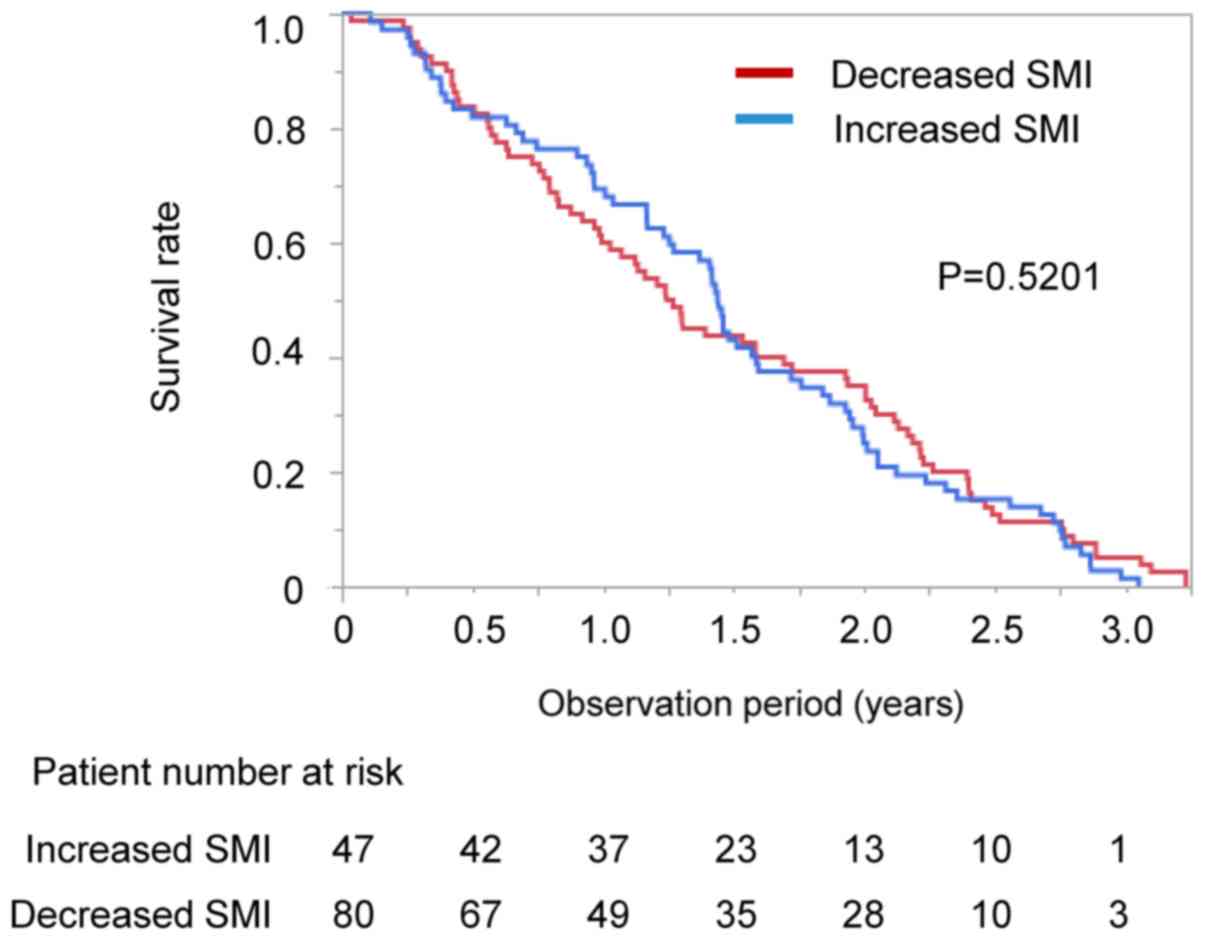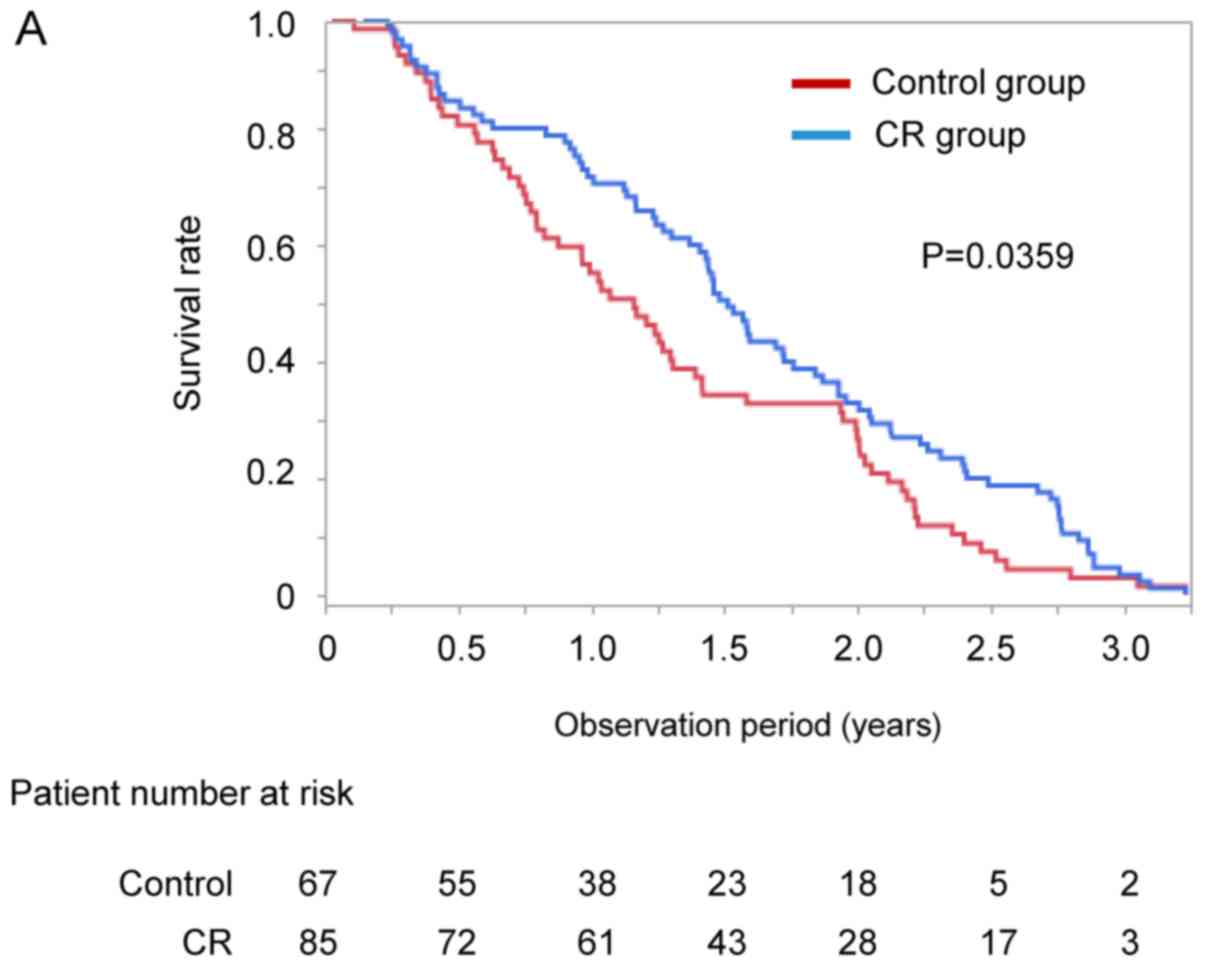|
1
|
Aberg MA, Toren K, Nilsson M, Henriksson
M, Kuhn HG, Nyberg J, Rosengren A, Åberg ND and Waern M:
Nonpsychotic mental disorders in teenage males and risk of early
stroke: A population-based study. Stroke. 47:814–821. 2016.
View Article : Google Scholar : PubMed/NCBI
|
|
2
|
Shimose S, Tanaka M, Iwamoto H, Niizeki T,
Shirono T, Aino H, Noda Y, Kamachi N, Okamura S, Nakano M, et al:
Prognostic impact of transcatheter arterial chemoembolization
(TACE) combined with radiofrequency ablation in patients with
unresectable hepatocellular carcinoma: Comparison with TACE alone
using decision-tree analysis after propensity score matching.
Hepatol Res. 49:919–928. 2019. View Article : Google Scholar : PubMed/NCBI
|
|
3
|
Windsor PM, Nicol KF and Potter J: A
randomized, controlled trial of aerobic exercise for
treatment-related fatigue in men receiving radical external beam
radiotherapy for localized prostate carcinoma. Cancer. 101:550–557.
2004. View Article : Google Scholar : PubMed/NCBI
|
|
4
|
Serra MC, Ryan AS, Ortmeyer HK, Addison O
and Goldberg AP: Resistance training reduces inflammation and
fatigue and improves physical function in older breast cancer
survivors. Menopause. 25:211–216. 2018. View Article : Google Scholar : PubMed/NCBI
|
|
5
|
Schmitz KH, Courneya KS, Matthews C,
Demark-Wahnefried W, Galvão DA, Pinto BM, Irwin ML, Wolin KY, Segal
RJ, Lucia A, et al: American College of Sports Medicine roundtable
on exercise guidelines for cancer survivors. Med Sci Sports Exerc.
42:1409–1426. 2010. View Article : Google Scholar : PubMed/NCBI
|
|
6
|
Mishra SI, Scherer RW, Geigle PM,
Berlanstein DR, Topaloglu O, Gotay CC and Snyder C: Exercise
interventions on health-related quality of life for cancer
survivors. Cochrane Database Syst Rev. CD0075662012.PubMed/NCBI
|
|
7
|
Nishikawa H, Shiraki M, Hiramatsu A,
Moriya K, Hino K and Nishiguchi S: Japan Society of Hepatology
guidelines for sarcopenia in liver disease (1st edition):
Recommendation from the working group for creation of sarcopenia
assessment criteria. Hepatol Res. 46:951–963. 2016. View Article : Google Scholar : PubMed/NCBI
|
|
8
|
Tsien C, Davuluri G, Singh D, Allawy A,
Ten Have GA, Thapaliya S, Schulze JM, Barnes D, McCullough AJ,
Engelen MP, et al: Metabolic and molecular responses to
leucine-enriched branched chain amino acid supplementation in the
skeletal muscle of alcoholic cirrhosis. Hepatology. 61:2018–2029.
2015. View Article : Google Scholar : PubMed/NCBI
|
|
9
|
Samoylova ML, Covinsky KE, Haftek M, Kuo
S, Roberts JP and Lai JC: Disability in patients with end-stage
liver disease: Results from the functional assessment in liver
transplantation study. Liver Transpl. 23:292–298. 2017. View Article : Google Scholar : PubMed/NCBI
|
|
10
|
Koo BK, Kim D, Joo SK, Kim JH, Chang MS,
Kim BG, Lee KL and Kim W: Sarcopenia is an independent risk factor
for non-alcoholic steatohepatitis and significant fibrosis. J
Hepatol. 66:123–131. 2017. View Article : Google Scholar : PubMed/NCBI
|
|
11
|
Iritani S, Imai K, Takai K, Hanai T, Ideta
T, Miyazaki T, Suetsugu A, Shiraki M, Shimizu M and Moriwaki H:
Skeletal muscle depletion is an independent prognostic factor for
hepatocellular carcinoma. J Gastroenterol. 50:323–332. 2015.
View Article : Google Scholar : PubMed/NCBI
|
|
12
|
García-Pagàn JC, Santos C, Barberá JA,
Luca A, Roca J, Rodriguez-Roisin R, Bosch J and Rodés J: Physical
exercise increases portal pressure in patients with cirrhosis and
portal hypertension. Gastroenterology. 111:1300–1306. 1996.
View Article : Google Scholar : PubMed/NCBI
|
|
13
|
Saló J, Guevara M, Fernández-Esparrach G,
Bataller R, Ginès A, Jimenez W, Ginès P, Rivera F, Arroyo V and
Rodés J: Impairment of renal function during moderate physical
exercise in cirrhotic patients with ascites: Relationship with the
activity of neurohormonal systems. Hepatology. 25:1338–1342. 1997.
View Article : Google Scholar : PubMed/NCBI
|
|
14
|
Hiraoka A, Michitaka K, Kiguchi D, Izumoto
H, Ueki H, Kaneto M, Kitahata S, Aibiki T, Okudaira T, Tomida H, et
al: Efficacy of branched-chain amino acid supplementation and
walking exercise for preventing sarcopenia in patients with liver
cirrhosis. Eur J Gastroenterol Hepatol. 29:1416–1423. 2017.
View Article : Google Scholar : PubMed/NCBI
|
|
15
|
Locklear CT, Golabi P, Gerber L and
Younossi ZM: Exercise as an intervention for patients with
end-stage liver disease: Systematic review. Medicine (Baltimore).
97:e127742018. View Article : Google Scholar : PubMed/NCBI
|
|
16
|
Koya S, Kawaguchi T, Hashida R, Goto E,
Matsuse H, Saito H, Hirota K, Taira R, Matsushita Y, Imanaga M, et
al: Effects of in-hospital exercise on liver function, physical
ability, and muscle mass during treatment of hepatoma in patients
with chronic liver disease. Hepatol Res. 47:E22–E34. 2017.
View Article : Google Scholar : PubMed/NCBI
|
|
17
|
Koya S, Kawaguchi T, Hashida R, Hirota K,
Bekki M, Goto E, Yamada M, Sugimoto M, Hayashi S, Goshima N, et al:
Effects of in-hospital exercise on sarcopenia in hepatoma patients
who underwent transcatheter arterial chemoembolization. J
Gastroenterol Hepatol. 34:580–588. 2019.PubMed/NCBI
|
|
18
|
Oken MM, Creech RH, Tormey DC, Horton J,
Davis TE, McFadden ET and Carbone PP: Toxicity and response
criteria of the Eastern Cooperative Oncology Group. Am J Clin
Oncol. 5:649–655. 1982. View Article : Google Scholar : PubMed/NCBI
|
|
19
|
Citro V, Milan G, Tripodi FS, Gennari A,
Sorrentino P, Gallotta G, Postiglione A and Tarantino G: Mental
status impairment in patients with West Haven grade zero hepatic
encephalopathy: The role of HCV infection. J Gastroenterol.
42:79–82. 2007. View Article : Google Scholar : PubMed/NCBI
|
|
20
|
Fukui H, Saito H, Ueno Y, Uto H, Obara K,
Sakaida I, Shibuya A, Seike M, Nagoshi S, Segawa M, et al:
Evidence-based clinical practice guidelines for liver cirrhosis
2015. J Gastroenterol. 51:629–650. 2016. View Article : Google Scholar : PubMed/NCBI
|
|
21
|
Writing Committee M, ; Yancy CW, Jessup M,
Bozkurt B, Butler J, Casey DE Jr, Drazner MH, Fonarow GC, Geraci
SA, Horwich T, et al: 2013 ACCF/AHA guideline for the management of
heart failure: A report of the American College of Cardiology
Foundation/American Heart Association Task Force on practice
guidelines. Circulation. 128:e240–e327. 2013.PubMed/NCBI
|
|
22
|
Heart Failure Society of America, ;
Lindenfeld J, Albert NM, Boehmer JP, Collins SP, Ezekowitz JA,
Givertz MM, Katz SD, Klapholz M, Moser DK, et al: HFSA 2010
comprehensive heart failure practice guideline. J Card Fail.
16:e1–e194. 2010. View Article : Google Scholar : PubMed/NCBI
|
|
23
|
Rochwerg B, Brochard L, Elliott MW, Hess
D, Hill NS, Nava S, Navalesi P; Members Of The Steering Committee,
; Antonelli M, Brozek J, Conti G, et al: Official ERS/ATS clinical
practice guidelines: Noninvasive ventilation for acute respiratory
failure. Eur Respir J. 50:2017. View Article : Google Scholar : PubMed/NCBI
|
|
24
|
Wedzicha JA Erc Co-Chair, Miravitlles M,
Hurst JR, Calverley PM, Albert RK, Anzueto A, Criner GJ, Papi A,
Rabe KF, Rigau D, et al: Management of COPD exacerbations: A
European Respiratory Society/American Thoracic Society guideline.
Eur Respir J. 49:2017. View Article : Google Scholar : PubMed/NCBI
|
|
25
|
Saeki I, Yamasaki T, Maeda M, Kawano R,
Hisanaga T, Iwamoto T, Matsumoto T, Hidaka I, Ishikawa T, Takami T
and Sakaida I: No muscle depletion with high visceral fat as a
novel beneficial biomarker of sorafenib for hepatocellular
carcinoma. Liver Cancer. 7:359–371. 2018. View Article : Google Scholar : PubMed/NCBI
|
|
26
|
Garber CE, Blissmer B, Deschenes MR,
Franklin BA, Lamonte MJ, Lee IM, Nieman DC and Swain DP; American
College of Sports Medicine, : American College of Sports Medicine
position stand. Quantity and quality of exercise for developing and
maintaining cardiorespiratory, musculoskeletal, and neuromotor
fitness in apparently healthy adults: Guidance for prescribing
exercise. Med Sci Sports Exerc. 43:1334–1359. 2011. View Article : Google Scholar : PubMed/NCBI
|
|
27
|
Forner A, Reig M and Bruix J:
Hepatocellular carcinoma. Lancet. 391:1301–1314. 2018. View Article : Google Scholar : PubMed/NCBI
|
|
28
|
Kudo M, Matsui O, Izumi N, Iijima H,
Kadoya M, Imai Y, Okusaka T, Miyayama S, Tsuchiya K, Ueshima K, et
al: JSH consensus-based clinical practice guidelines for the
management of hepatocellular carcinoma: 2014 update by the liver
cancer study group of Japan. Liver Cancer. 3:458–468. 2014.
View Article : Google Scholar : PubMed/NCBI
|
|
29
|
Teramoto T, Sasaki J, Ishibashi S, Birou
S, Daida H, Dohi S, Egusa G, Hiro T, Hirobe K, Iida M, et al:
Metabolic syndrome. J Atheroscler Thromb. 21:1–5. 2014. View Article : Google Scholar : PubMed/NCBI
|
|
30
|
Schneider CA, Rasband WS and Eliceiri KW:
NIH Image to ImageJ: 25 years of image analysis. Nat Methods.
9:671–675. 2012. View Article : Google Scholar : PubMed/NCBI
|
|
31
|
Hashida R, Matsuse H, Takano Y, Omoto M,
Nago T and Shiba N: Walking exercise combined with neuromuscular
electrical stimulation of antagonist resistance improved muscle
strength and physical function for elderly people: A pilot study. J
Phys Fitness Sports Med. 5:195–203. 2016. View Article : Google Scholar
|
|
32
|
Brooks D, Solway S and Gibbons WJ: ATS
statement on six-min walk test. Am J Respir Crit Care Med.
167:12872003. View Article : Google Scholar : PubMed/NCBI
|
|
33
|
Kawaguchi T, Tokushige K, Hyogo H, Aikata
H, Nakajima T, Ono M, Kawanaka M, Sawada K, Imajo K, Honda K, et
al: A data mining-based prognostic algorithm for NAFLD-related
hepatoma patients: A nationwide study by the Japan study group of
NAFLD. Sci Rep. 8:104342018. View Article : Google Scholar : PubMed/NCBI
|
|
34
|
Dawson JK, Dorff TB, Todd Schroeder E,
Lane CJ, Gross ME and Dieli-Conwright CM: Impact of resistance
training on body composition and metabolic syndrome variables
during androgen deprivation therapy for prostate cancer: A pilot
randomized controlled trial. BMC Cancer. 18:3682018. View Article : Google Scholar : PubMed/NCBI
|
|
35
|
Hirota K, Kawaguchi T, Hashida R, Koya S,
Bekki M, Goshima N, Yoshiyama T, Otsuka T, Nozoe R, Nakano D, et
al: Profiles associated with Sarcopenia in hepatoma patients
underwent transcatheter arterial chemoembolization: A data-mining
analysis. J Cachexia Sarcopenia Muscle Clin Rep. 3:e000662018.
|
|
36
|
Bhasin S, Woodhouse L and Storer TW: Proof
of the effect of testosterone on skeletal muscle. J Endocrinol.
170:27–38. 2001. View Article : Google Scholar : PubMed/NCBI
|
|
37
|
Yakabe M, Kojima T, Okumura T, Takiyama S,
Umeda-Kameyama Y, Akishita M and Ogawa S: Serum free testosterone
levels are positively correlated with skeletal muscle mass in older
women aged over 75 years. Geriatr Gerontol Int. 19:460–461. 2019.
View Article : Google Scholar : PubMed/NCBI
|
|
38
|
Okamura Y, Sugiura T, Ito T, Yamamoto Y,
Ashida R and Uesaka K: The optimal cut-off value of the
preoperative prognostic nutritional index for the survival differs
according to the TNM stage in hepatocellular carcinoma. Surg Today.
47:986–993. 2017. View Article : Google Scholar : PubMed/NCBI
|
|
39
|
Meneses-Echávez JF, Jiménez EG, Rio-Valle
JS, Correa-Bautista JE, Izquierdo M and Ramírez-Vélez R: The
insulin-like growth factor system is modulated by exercise in
breast cancer survivors: A systematic review and meta-analysis. BMC
Cancer. 16:6822016. View Article : Google Scholar : PubMed/NCBI
|
|
40
|
Devin JL, Bolam KA, Jenkins DG and Skinner
TL: The influence of exercise on the insulin-like growth factor
axis in oncology: Physiological basis, current, and future
perspectives. Cancer Epidemiol Biomarkers Prev. 25:239–249. 2016.
View Article : Google Scholar : PubMed/NCBI
|
|
41
|
Yu M, King B, Ewert E, Su X, Mardiyati N,
Zhao Z and Wang W: Exercise activates p53 and negatively regulates
IGF-1 pathway in epidermis within a skin cancer model. PLoS One.
11:e01609392016. View Article : Google Scholar : PubMed/NCBI
|
|
42
|
San-Millán I and Brooks GA: Reexamining
cancer metabolism: Lactate production for carcinogenesis could be
the purpose and explanation of the Warburg Effect. Carcinogenesis.
38:119–133. 2017.PubMed/NCBI
|
|
43
|
Hofmann P: Cancer and exercise: Warburg
hypothesis, tumour metabolism and high-intensity anaerobic
exercise. Sports (Basel). 6:2018.PubMed/NCBI
|
|
44
|
Lucia A and Ramírez M: Muscling in on
cancer. N Engl J Med. 375:892–894. 2016. View Article : Google Scholar : PubMed/NCBI
|
|
45
|
Pedersen L, Idorn M, Olofsson GH,
Lauenborg B, Nookaew I, Hansen RH, Johannesen HH, Becker JC,
Pedersen KS, Dethlefsen C, et al: Voluntary running suppresses
tumor growth through epinephrine- and IL-6-dependent NK cell
mobilization and redistribution. Cell Metab. 23:554–562. 2016.
View Article : Google Scholar : PubMed/NCBI
|
|
46
|
Hojman P, Dethlefsen C, Brandt C, Hansen
J, Pedersen L and Pedersen BK: Exercise-induced muscle-derived
cytokines inhibit mammary cancer cell growth. Am J Physiol
Endocrinol Metab. 301:E504–E510. 2011. View Article : Google Scholar : PubMed/NCBI
|
|
47
|
Aoi W, Naito Y, Takagi T, Tanimura Y,
Takanami Y, Kawai Y, Sakuma K, Hang LP, Mizushima K, Hirai Y, et
al: A novel myokine, secreted protein acidic and rich in cysteine
(SPARC), suppresses colon tumorigenesis via regular exercise. Gut.
62:882–889. 2013. View Article : Google Scholar : PubMed/NCBI
|
|
48
|
Panão I and Carraça EV: Effects of
exercise motivations on body image and eating habits/behaviours: A
systematic review. Nutr Diet. 2019.
|
|
49
|
Kerr J, Anderson C and Lippman SM:
Physical activity, sedentary behaviour, diet, and cancer: An update
and emerging new evidence. Lancet Oncol. 18:e457–e471. 2017.
View Article : Google Scholar : PubMed/NCBI
|
|
50
|
Koelwyn GJ, Quail DF, Zhang X, White RM
and Jones LW: Exercise-dependent regulation of the tumour
microenvironment. Nat Rev Cancer. 17:620–632. 2017. View Article : Google Scholar : PubMed/NCBI
|

















